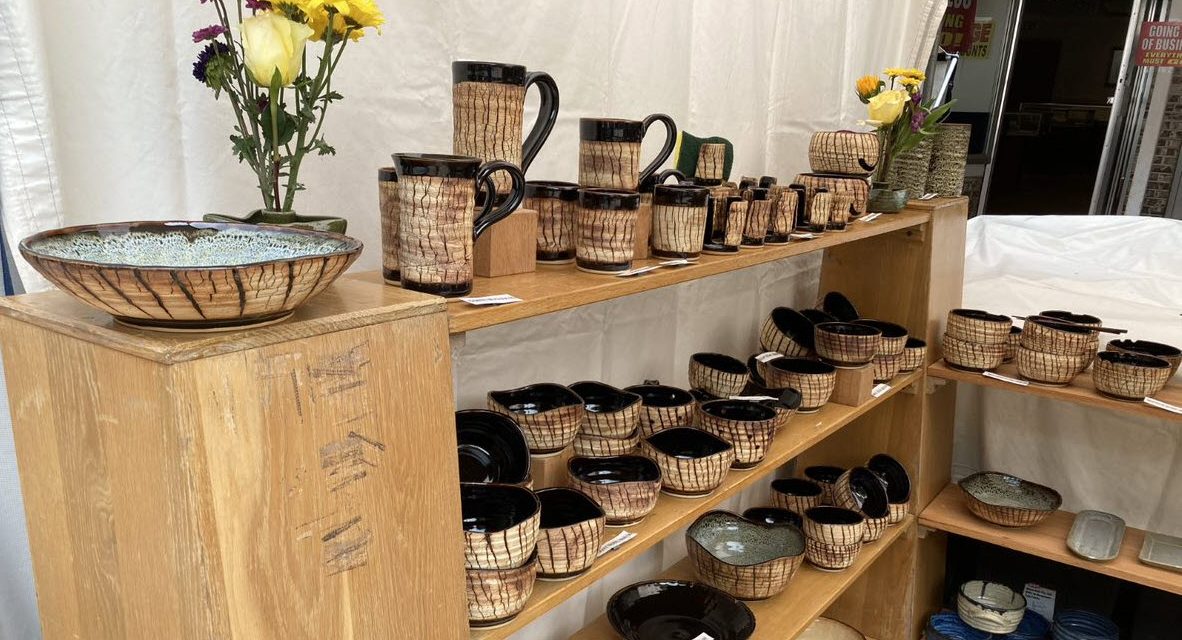By Patrice Lewis
Well, today’s the big day, the day of your first craft show. You selected an appropriate venue. You arrived on time. You’re displaying only juried items. Your booth is handsome and well-done. The only problem is…you’re competing with other vendors at the event. Now what? How do you bring customers into your booth?
Selling at Craft Fairs: The obvious stuff
It should go without saying your booth is attractive and not sloppy. Tables should have floor-length tablecloths so you can tuck crates, boxes and extra stock underneath, rather than shoving them in the back. Your displays should be uncluttered, clean and easy to view. You should be wearing clothing that is neat and professional (whether a costume or street clothes). You should have a nice, friendly smile.
All of this is pretty standard stuff. Yet if you still have trouble selling your wares, then it’s time to look deeper into the psychology of selling at a craft fair.
Are your products too cheap? Find out here
The not-so-obvious stuff
One of the easiest things to learn is how to sell your wares by placing yourself in your customers’ shoes. How would you want to be treated in a booth?
Many years ago I taught an adult education class on how to turn a craft hobby into a business. The subject of sales techniques came up. I explained how customers don’t like to feel pressured when they enter a booth. They don’t want to be backed into a corner in order to have the merits of the product explained to them. Very few people will purchase a product under these circumstances, unless it’s just to escape the craftsperson.
My students understood this concept…I thought. Yet after the class was finished, one woman came up to me, almost literally backed me into a corner, and started telling how her husband sells a gizmo that increases the gas mileage on cars, and if I buy one right now she’ll take 25 percent off the price, and she accepts both Visa and MasterCard, and how many gizmos did I want?
Okay, so she didn’t get it. She didn’t get my concept, and she sure as heck didn’t get my sale.
Take a lesson from used car lots
Selling takes a certain psychology, as any good salesperson will tell you. When customers are browsing, the last thing they want is to feel pressured.
You know all those old stereotypical jokes about the used car salesman following you around the lot, talking continuously and trying to force a sale? What do you do when that happens? You start to walk more quickly. You want to get away. You don’t take the time to look at the cars thoroughly because you hate having the person dogging your steps.
Used car salesmen do sell cars. They must, or they’d be out of business. But there’s a difference between a car lot and a crafts fair. People go to car lots specifically to buy a car, and they’ll put up with the salesman because they want a car. People do not (usually) go to a crafts fair specifically to buy your product. That’s a critical distinction.
Do not—ever—become the craftperson’s equivalent of a used car salesman, or you will find your booth empty of customers. Treat your customers respectfully.
Did you know that most people will decide whether they like you or not within ten seconds of meeting you? That’s why first impressions are so important, and never more than when you’re trying to get someone to part with money. Believe me, if a customer likes your product but doesn’t like you, they won’t buy the product.
To talk or not to talk
Sometimes, when a customer walks into a booth, you need to make a snap decision whether to engage them in conversation or not. I remember one time a woman with a beautiful toddler came into the booth. I love children, and my first instinct was to coo and fuss over the child. However, I made a snap decision not to admire the kid, because the proud mama’s attention would be diverted from browsing my products to talking about her child. So I merely said hello, and let her browse. Sure enough, she bought something…and then I had my chance to gush over the child while I rang up the sale.
Come up with a line that can get across critical sales points in very few words. For example, we make hardwood drinking tankards. For some reason, a common reaction when customers first see one is to assume it’s merely decorative, not functional. So rather than launching into a long-winded explanation, I’ll say something half-joking like, “Those make great coffee cups!” In five words, I’ve explained two critical concepts: 1) the tankards are usable; and 2) they will hold hot as well as cold beverages.
Are your products too cheap? Find out here
Use humor
Never underestimate the importance of humor to put people at ease. I don’t mean you should run a vaudeville show from your booth, (although, I know someone who does just that successfully) but be prepared with a few standard jokes to break the ice. The secret is to not make the jokes sound canned.
Customers like humor because it’s relaxing. When a customer picks up one of our crooked tankards, we’ll explain it’s our public service tankard because when it appears straight, they’ve had too much. Lame, yes, but everyone gets a chuckle, and the customer can look with greater interest at the mug as a result. And now they feel more comfortable asking questions about the product without feeling pressure.
My husband (who has an uncanny ability to mimic foreign accents) will adopt an Irish brogue or a Scottish burr or a German accent (depending on if we’re at a Renaissance Faire, an Oktoberfest, or whatever) when explaining things to customers. He gets a huge reaction to this. On the other hand, I know my own limits (meaning I stink at accents) so I have to take a different sales approach.
Learn your venue
Obviously different sales techniques work at different venues. You can’t be loud and boisterous at a wine tasting. Nor should you be quiet and murmuring at a Renaissance Faire. The different venues have different demographics of customers, who in turn respond to different types of sales techniques.
You must also find the techniques that work with your particular personality. My friend who does a quasi-vaudeville act is a hilarious sit-down comic (he’s in a wheelchair) and can come up with witty one-liners at the drop of a hat…which has the added advantage of putting people at ease around his wheelchair. Other people adopt a droll, straight-faced style of humor (think of Bob Newhart) that can work wonders. Yet others avoid humor altogether because they know they can’t pull it off.
Through experience, you will learn what works for you. Learn from customers’ reactions. If they smile uneasily and look for a hasty reason to leave when you launch into your spiel, then that should tell you something. If customers give you funny looks and don’t laugh when you try to crack a joke, back down from the attempts at humor. And—most of all—if customers seem to like product but don’t buy anything after meeting you, then you could have a lot to learn.
The basics
There is always an element of risk for a customer when he walks into a booth. Make him feel comfortable by merely offering a neutral but friendly greeting (“Good morning!”). You’ve acknowledged the customer without making any additional demands. Don’t start peppering him with unwanted information (“We’re having a sale today on blue-satin widgets! Just look at the quality of these things…they’ll last for years!”). If you do that, I can almost guarantee the customer will backpedal out of your booth with a mumbled excuse about meeting Cousin Bob somewhere else.
Naturally you’ll be available to answer specific questions about your product, but answer in such a way that does not imply you now expect them to buy something (“That widget is made out of solid walnut…so, can I wrap it up for you?”). Don’t talk too much—customers generally want to be left alone to make up their minds.
It’s a fine balance. Being friendly with your customers improves your chances of selling something, but trying to make them your best friend by nagging them will damage your sales—and your reputation.
And, of course, most people will walk into a booth, and then walk out again. Most won’t buy anything—at least, not yet. It’s up to you to make their brief browsing experience so pleasant and pressure-free they’ll feel free to come back later and buy.







